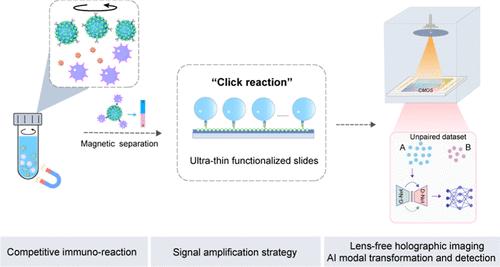基于非配对数据集信噪比增强模态变换的无透镜全息成像免疫传感器
IF 6.7
1区 化学
Q1 CHEMISTRY, ANALYTICAL
引用次数: 0
摘要
传统的显微镜在透镜和视场(FOV)之间调和的能力有限。因此,免疫传感器的成像范围和精度仍然受到限制。在本研究中,提出了一种全息深度学习非配对模态变换辅助免疫传感器,将便携式无透镜全息成像设备与基于CuO2@SiO2纳米颗粒的点击反应信号放大策略相结合,用于准确检测抗生素。该免疫传感器通过构建非配对数据集的模态变换模型,实现了大视场成像(比显微镜提高10.3倍)和信噪比增强全息重建(信噪比32.65 dB,结构相似指数0.83),解决了传统方法需要的数据集一对一匹配的复杂性。该免疫传感器在40 min内检测出氯霉素,灵敏度高,线性范围宽(检出限为3.54 pg/mL,动态范围为10 pg/mL ~ 50 ng/mL),作为便携式检测设备,具有作为食品安全检查和临床诊断的灵敏现场检测平台的潜力。本文章由计算机程序翻译,如有差异,请以英文原文为准。

Lens-Free Holographic Imaging-Based Immunosensor Using Unpaired Data Set Signal-to-Noise Ratio-Enhanced Modal Transformation for Biosensing
Conventional microscopes have limited capacities to reconcile the trade-off between the lens and field of view (FOV). Thus, the imaging field and accuracy of immunosensors remain restricted. In this study, a holographic deep learning unpaired modal transformation-assisted immunosensor is presented, combining a portable lens-free holographic imaging device with a CuO2@SiO2 nanoparticle-based click reaction signal amplification strategy for accurate antibiotic detection. The immunosensor achieves both large FOV imaging (10.3-fold improvement over the microscope) and signal-to-noise ratio-enhanced holographic reconstruction (signal-to-noise ratio of 32.65 dB, structural similarity index of 0.83) by constructing a modal transformation model with unpaired data sets, thus resolving the complexity of one-to-one matching of data sets required by conventional methods. The immunosensor detects chloramphenicol with high sensitivity and a wide linear range (limit of detection = 3.54 pg/mL, dynamic range of 10 pg/mL to 50 ng/mL) within 40 min. As a portable detection device, it demonstrates potential as a sensitive and on-site detection platform for food safety inspection and clinical diagnosis.
求助全文
通过发布文献求助,成功后即可免费获取论文全文。
去求助
来源期刊

Analytical Chemistry
化学-分析化学
CiteScore
12.10
自引率
12.20%
发文量
1949
审稿时长
1.4 months
期刊介绍:
Analytical Chemistry, a peer-reviewed research journal, focuses on disseminating new and original knowledge across all branches of analytical chemistry. Fundamental articles may explore general principles of chemical measurement science and need not directly address existing or potential analytical methodology. They can be entirely theoretical or report experimental results. Contributions may cover various phases of analytical operations, including sampling, bioanalysis, electrochemistry, mass spectrometry, microscale and nanoscale systems, environmental analysis, separations, spectroscopy, chemical reactions and selectivity, instrumentation, imaging, surface analysis, and data processing. Papers discussing known analytical methods should present a significant, original application of the method, a notable improvement, or results on an important analyte.
 求助内容:
求助内容: 应助结果提醒方式:
应助结果提醒方式:


